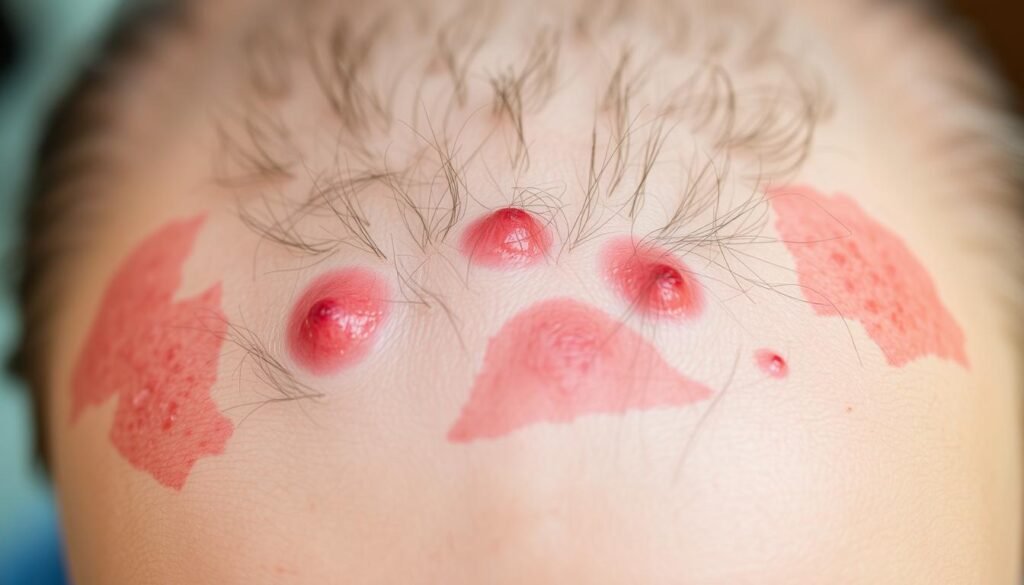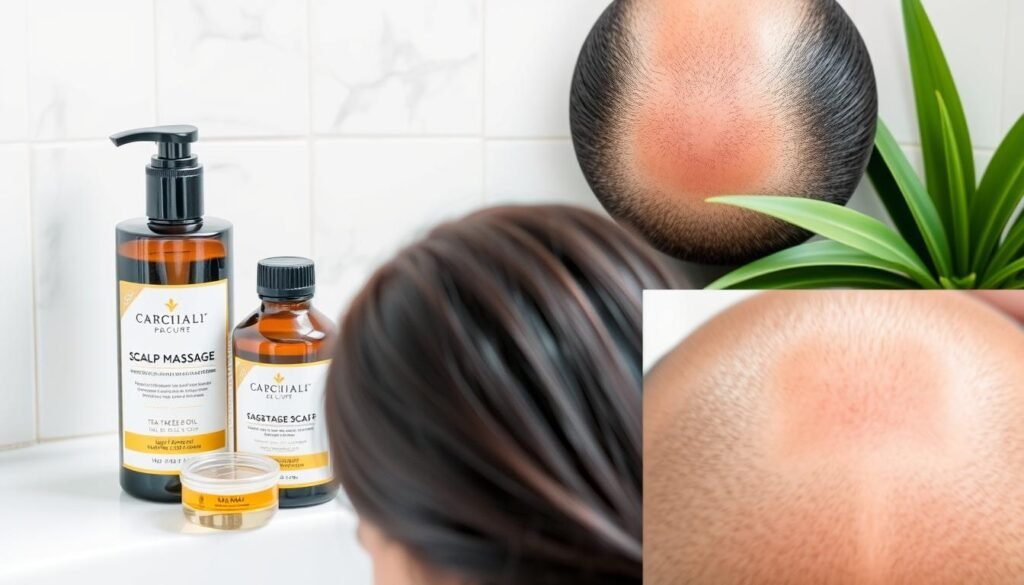About 20% of all scalp folliculitis cases are caused by fungus. This fact highlights a lesser-known side of a condition that is often misdiagnosed or overlooked. Scalp folliculitis affects the hair follicles and can cause significant hair loss if not properly treated. Knowing how to effectively treat this hair loss is crucial.
This article will explore the causes, symptoms, and treatments for scalp folliculitis. We will talk about everything from medications you can buy without a prescription to home remedies. By understanding scalp folliculitis better, you can choose the best treatment and make changes to your lifestyle to help your scalp and hair.
Key Takeaways
- Understanding the prevalence and causes of scalp folliculitis is crucial for effective treatment.
- Identifying symptoms early can help prevent further complications and hair loss.
- Effective treatments range from over-the-counter products to prescription medications.
- Home remedies and hygiene practices can play a significant role in managing the condition.
- Regular check-ins with a healthcare provider are recommended for persistent issues.
Understanding Scalp Folliculitis
Scalp folliculitis is common and involves inflammation of hair follicles. This results in small, painful bumps, redness, and swelling. Things like bacterial or fungal infections, ingrown hairs, and reactions to medications can cause it.
Though it’s non-contagious, scalp folliculitis can get worse if personal hygiene items are shared. Being in places that are moist, like public hot tubs, raises the risk because of bacteria exposure, like Pseudomonas. Knowing about this condition early on is crucial for managing it properly.
Keeping clean is key to avoiding scalp issues. For people with certain health problems, like diabetes, the risk is higher. Being aware of these facts is important. It helps in being cautious about scalp folliculitis.
Causes of Scalp Folliculitis
Scalp folliculitis happens due to many things that inflame hair follicles. A big cause is bacterial infection, mainly from Staphylococcus aureus. This usually happens when hair follicles get hurt, leading to swelling. Doing things like scratching a lot, wearing tight hairstyles, or pulling hair can make it worse.
Fungal infections can also be a big player. Conditions like Tinea capitis show how fungi can get into hair follicles, causing itchiness and discomfort. These infections hit harder in people with weak immune systems or those who don’t keep their scalp clean.
Wearing tight hats or helmets can rub the scalp wrong. This friction makes the scalp more likely to get infections. Not washing your hair enough can also make things worse. It leads to more oil and dirt, which can cause infections.
Guys, especially those with coarse or curly hair, tend to get this more. This hair type can get irritated easier, making scalp folliculitis more likely.
| Factor | Description | Impact |
|---|---|---|
| Bacterial Infection | Caused by Staphylococcus aureus and other bacteria. | Leads to inflammation and potential pus formation. |
| Fungal Infection | Includes Tinea capitis and similar conditions. | May cause itchy and inflamed hair follicles. |
| Irritants | Tight hats, helmets, and improper shaving techniques. | Can damage hair follicles, increasing risk. |
| Poor Scalp Hygiene | Infrequent washing leads to dirt and oil buildup. | Creates an environment where infections can thrive. |
| Demographics | Males with thick or curly hair. | Higher likelihood of experiencing irritation. |
Recognizing Scalp Folliculitis Symptoms
Identifying symptoms of scalp folliculitis early is key. Many people first see small, red bumps near their hairline. These can grow into larger sores filled with pus, causing a lot of discomfort.
Other signs include itching that disrupts daily life and a burning feeling on the scalp. You may also experience pain or tenderness at the inflammation site, and sometimes a mild fever.
If you spot these symptoms, it’s smart to talk to a doctor. This can help avoid problems like scarring or losing hair forever. About 30% of people with ongoing issues face these challenges.
Knowing the early signs of scalp folliculitis is crucial. This knowledge lets you act fast to get treatment. It also helps keep your scalp healthy and prevents long-term problems.
| Symptom | Description |
|---|---|
| Small Bumps | Initial lesions that form at hair follicles |
| Pus-Filled Sores | Larger lesions that may develop from initial bumps |
| Itching | Severe discomfort that can impact daily life |
| Burning Sensation | A painful feeling that may accompany inflammation |
| Tenderness | Pain at the site of inflamed areas |
| Mild Fever | Possible sign of infection |
Scalp Folliculitis Hair Loss: How It Occurs
Scalp folliculitis is a big problem for hair. It’s caused by inflammation that harms hair follicles. This can stop hairs from growing and lead to bald spots. If not treated, it gets worse and may cause permanent hair loss. This happens as scar tissue takes over damaged follicles.
Impact of Inflammation on Hair Follicles
Normally, hair follicles on a healthy scalp grow well. But, with scalp folliculitis, inflammation upsets this growth. It can damage follicles, causing sores or oozing wounds. This damage keeps hair from growing right. Fixing this quickly helps stop more damage and hair loss.
Potential for Permanent Hair Loss
Without treatment, permanent hair loss could happen. Bad folliculitis might lead to cicatricial alopecia. This means scar tissue replaces hair follicles and hair can’t grow back. Knowing these risks is crucial. It’s important to treat scalp problems early. For more details on hair loss from folliculitis, read this detailed guide.

Common Types of Scalp Folliculitis
Scalp folliculitis comes in many forms, each unique in traits and how to treat it. Knowing these can help manage and heal the condition.
Bacterial Folliculitis
Bacterial folliculitis is mainly due to Staphylococcus aureus. It causes inflamed bumps and pus-filled spots. Spotting it early is key to prevent it from turning into painful boils. Itchy spots start small and can grow into larger sores if not treated.
Fungal Folliculitis
Fungal folliculitis is caused by yeast, especially Malassezia. You need antifungal medicine to treat it. It can be quite uncomfortable and make other scalp problems worse.
Pseudofolliculitis Barbae
Pseudofolliculitis barbae, or barber’s itch, is from hairs growing back into the skin. It makes red bumps and severe inflammation, especially in people who shave a lot. Using the right shaving methods and skin care can lower the chances of getting it.
Effective Treatment for Scalp Folliculitis
The right treatment for scalp folliculitis varies depending on its type and how severe it is. There are different ways to ease symptoms and help the healing process. Knowing what options you have is key to managing it well.
Over-the-Counter Medications
For mild scalp folliculitis, over-the-counter medicines might help. Topical antibiotics and creams can reduce bacteria and ease pain. Using antifungal shampoos can be good against fungal infections, like those from Malassezia fungi. These products are often effective and don’t need a prescription. You can find more helpful advice here.
Prescription Treatments
If you have a severe case, you might need a doctor’s help. A dermatologist can prescribe oral antibiotics for tough infections. They may suggest topical steroids to lessen swelling and irritation. Sometimes, oral isotretinoin or light therapy is used for hard-to-treat infections. It’s best to talk with a healthcare provider to find the right treatment. For more information, look here.

| Treatment Type | Description | Common Uses |
|---|---|---|
| Over-the-Counter Medications | Topical antibiotics, soothing creams, antifungal shampoos | Mild cases of scalp folliculitis |
| Prescription Treatments | Oral antibiotics, topical steroids, isotretinoin, light therapy | Severe or persistent cases |
Scalp Folliculitis Remedies and Home Treatments
Mild scalp folliculitis can often be managed at home. Many find relief with home remedies. These can speed up recovery and comfort.
Effective home treatments include:
- Warm Compresses: Soothe inflammation and discomfort.
- Gently Antibacterial Shampoos: Helps keep the scalp clean and eases symptoms.
- Avoiding Irritating Products: Avoid harsh chemicals to reduce irritation.
- Regular Cleaning: Daily washing with mild products prevents bacteria buildup.
- Hydrocortisone Cream: This cream reduces itching and swelling.
Natural treatments also help with symptoms. Use ingredients with antibacterial and antifungal properties.
- Tea Tree Oil: Its antimicrobial effects help when applied directly.
- Apple Cider Vinegar: Helps restore scalp balance and reduces itch.
- Turmeric: Soothes irritated skin with its anti-inflammatory qualities.
If symptoms persist, seeing a dermatologist is wise. They can suggest the next steps if home remedies fail.
| Remedy Type | Benefits | Suggestions |
|---|---|---|
| Warm Compress | Soothes inflammation | Apply for 10-15 minutes, twice daily |
| Gentle Antibacterial Shampoo | Maintains scalp hygiene | Use every other day |
| Tea Tree Oil | Antimicrobial properties | Mix with a carrier oil before applying |
| Hydrocortisone Cream | Reduces swelling and itching | Apply sparingly once or twice daily |
| Apple Cider Vinegar | Restores balance | Dilute with water and rinse |
Using these remedies and treatments can improve comfort for those with scalp folliculitis.
Scalp Folliculitis Prevention Tips
To prevent scalp folliculitis, keep your scalp clean and avoid things that can irritate it. Following hygiene tips can greatly reduce the risk of getting this annoying condition.
Wash your scalp with a soft shampoo to fight off bad bacteria and fungi. This keeps your scalp clean and helps control oil. It creates a healthy environment that prevents infections like those caused by Staphylococcus aureus. Washing your hair 2-3 times a week is best. Washing less often can let bacteria grow, which can cause folliculitis.
Don’t share things like combs, hats, or towels. This helps stop the spread of bacteria or fungi. Wearing tight hats can bother your scalp. So, it’s better to wear loose hats. Be careful when shaving. Use clean, sharp razors and shave the way your hair grows. This helps avoid ingrown hairs that could cause problems.
It’s also good to exfoliate regularly. This helps keep hair follicles open. Avoiding tight hairstyles can also help, as they can make scalp folliculitis worse. Eating well is important too. A diet full of vitamins and minerals supports healthy skin and hair. This helps with scalp folliculitis prevention.
| Prevention Method | Description |
|---|---|
| Regular Washing | Wash the scalp 2-3 times weekly with a gentle shampoo to keep hygiene top-notch. |
| Avoid Sharing Items | Do not share hats, combs, or towels to reduce the risk of infections. |
| Choose Loose Headgear | Avoid tight-fitting hats and hairstyles that irritate the scalp. |
| Use Clean Razors | When shaving, use clean razors and shave with the hair growth direction. |
| Regular Exfoliation | Exfoliate to prevent clogged hair follicles and promote skin health. |
| Maintain a Balanced Diet | A diet rich in nutrients supports healthy hair growth and scalp condition. |

When to See a Dermatologist
If you have bad symptoms of scalp folliculitis, you should talk to a professional. These include lots of itching, pustules that stick around, or signs of infection like a fever. Knowing when to seek help is key to avoid worse problems. A scalp folliculitis dermatologist can figure out what’s wrong and suggest the right treatments.
People with health problems like diabetes or HIV/AIDS might get worse complications from folliculitis. Those with curly hair or prone to ingrown hairs need to watch out, especially for issues like pseudofolliculitis barbae. Getting help early is important in these cases.
Trying to fix it yourself for too long could make things worse, leading to ongoing infections or scars. Getting a dermatologist’s help can stop these problems and help manage the condition well.
Conclusion
Understanding scalp folliculitis is key for keeping your scalp healthy and avoiding hair loss. This condition involves inflammation and infection that can cause hair to fall out, especially in serious cases. If you catch the symptoms early, you can start treatments that help prevent worse damage.
There are many ways to treat this. For lighter cases, topical antibiotics can help. But for tougher situations, you might need oral medications like doxycycline. Isotretinoin is another option for very stubborn cases. It’s important to treat the condition but also to prevent it to keep your scalp healthy.
If you’re dealing with this problem often, it’s a good idea to see a doctor for advice. Getting the right care not only helps now but can also ensure your scalp stays healthy for the future. Handling scalp folliculitis well can mean better health and more hair.
